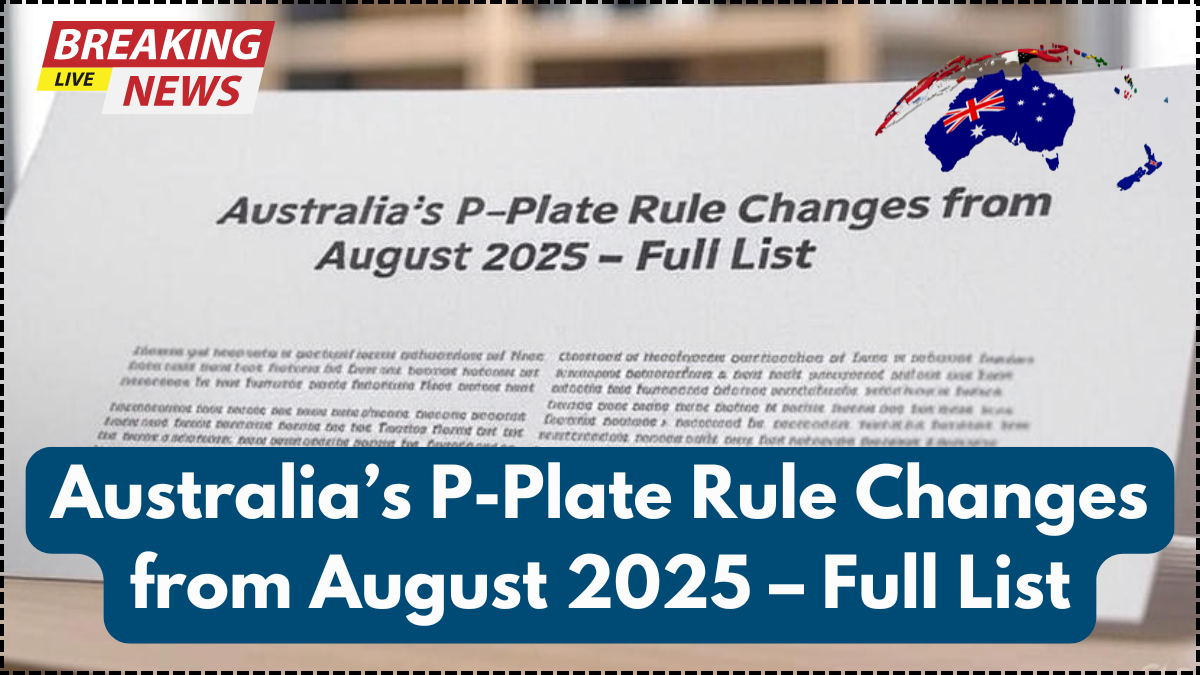New changes to the P-Plate Rules Australia are set to take effect from August 2025, marking one of the most comprehensive road regulation updates for provisional drivers in recent years. These updates aim to improve road safety, reduce accident rates, and ensure that young and new drivers develop responsible driving habits during their early years on the road.
These new road restrictions 2025 impact various aspects of P-plater driving—ranging from night-time driving limitations to stricter passenger rules. Whether you’re a current provisional license holder or planning to apply for one, it’s crucial to understand how these new regulations will affect your driving privileges.
Let’s explore what’s changing, what stays the same, and how P-platers can stay compliant and safe in 2025 and beyond.

What Are P-Plates in Australia?
In Australia, P-Plates (Provisional Plates) are issued to new drivers who have passed their learner’s test and are transitioning to full driving privileges. There are generally two phases:
-
P1 Licence (Red P): Typically held for the first 12 months.
-
P2 Licence (Green P): Usually held for 2–3 years after P1.
Both stages come with specific restrictions and expectations, and beginning in August 2025, those rules are being upgraded under the P-Plate Rules Australia reform.
Key P-Plate Rule Changes in August 2025
From August 1, 2025, all states and territories in Australia will begin enforcing a unified set of new road restrictions 2025 specifically for P-plate drivers. Here’s what’s changing:
-
Passenger Curfew: P1 drivers under 21 are prohibited from carrying more than one passenger under 21 between 10 PM and 5 AM.
-
Zero Tolerance for Speeding: Any speeding offense will now result in an automatic 3-month licence suspension for P1 drivers.
-
Phone Use Ban Extended: Even hands-free mobile use is now banned for both P1 and P2 drivers.
-
Engine Power Restrictions Expanded: New categories of turbocharged and high-performance hybrid vehicles have been added to the banned list for P-platers.
-
Mandatory Dashcams: New provisional license holders must now have dashcams installed and operational during all driving hours.
State-by-State Summary of P-Plate Updates
Each state will adopt the new rules, but there may be minor differences depending on local road safety authorities. Here’s a breakdown:
| State/Territory | Passenger Rule | Speeding Penalty | Phone Ban | Dashcam Mandate |
|---|---|---|---|---|
| New South Wales | Yes | Yes | Yes | Yes |
| Victoria | Yes | Yes | Yes | Yes |
| Queensland | Yes | Yes | Yes | Yes |
| South Australia | Yes | Yes | Yes | Yes |
| Western Australia | Yes | Yes | Yes | Yes |
| Tasmania | Yes | Yes | Yes | Yes |
| Northern Territory | Yes | Yes | Yes | Yes |
| ACT | Yes | Yes | Yes | Yes |
These P-Plate Rules Australia changes aim to reduce the disproportionately high accident rates among young drivers, especially during night-time hours and high-speed zones.
Why Are These New Road Restrictions Important?
Data from 2023–2024 revealed that P-plate drivers were 3 times more likely to be involved in road accidents, especially during the first 6 months after receiving their provisional licence. Factors such as distracted driving, peer pressure from passengers, and overconfidence behind the wheel contributed to these incidents.
These new road restrictions 2025 are grounded in research and international road safety best practices. Key goals include:
-
Reducing night-time road fatalities
-
Discouraging mobile phone use while driving
-
Preventing access to high-performance vehicles
-
Increasing driver accountability via dashcam footage
What P-Platers and Parents Should Do Now
If you or your child is about to transition to a P1 or P2 licence, now is the time to prepare:
-
Install a compliant dashcam before the August deadline
-
Educate yourself on new vehicle restrictions before purchasing or borrowing a car
-
Plan alternative transport during curfew hours if traveling with multiple young passengers
-
Avoid all mobile phone use, even hands-free options
Taking these steps now will help new drivers avoid penalties and drive more responsibly from day one.
Conclusion
The updated P-Plate Rules Australia represent a firm but necessary shift in how provisional licensing works. As road conditions and driving habits evolve, so must the laws that govern young drivers. By enforcing these new road restrictions 2025, Australia aims to create a safer driving environment and prepare young motorists for long-term road safety.
If you’re a P-plater, parent, or instructor, understanding and adapting to these changes is essential. With the right preparation and mindset, these rules will not only protect lives but also build better drivers for the future.
FAQs
What are the major P-Plate rule changes in August 2025?
Key changes include a night-time passenger curfew, mandatory dashcams, an extended phone use ban, and expanded vehicle restrictions.
Are dashcams now mandatory for all P-plate drivers?
Yes, from August 1, 2025, all new P1 and P2 drivers must have an operational dashcam while driving.
Can P1 drivers carry passengers at night?
Only one passenger under 21 is allowed between 10 PM and 5 AM for drivers under the age of 21.
Do these new rules apply across all of Australia?
Yes, although states may implement them slightly differently, the core rules are uniform nationwide.
Will hands-free phone use be allowed for P-plate drivers?
No, all mobile phone use—including hands-free—is banned for both P1 and P2 licence holders under the new restrictions.
Click here to learn more



